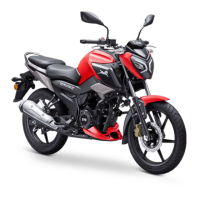
Do you have a question about the TVS Stryker 125 and is the answer not in the manual?
| Displacement | 124.53 cc |
|---|---|
| Maximum Torque | 10.8 Nm @ 5500 rpm |
| Brakes (Front) | Disc |
| Brakes (Rear) | Drum |
| Tyre (Front) | 2.75 x 17 |
| Tyre (Rear) | 3.00 x 17 |
| Ground Clearance | 173 mm |
| Kerb Weight | 117 kg |
| Engine Type | Air Cooled |
| Gearbox | 4 Speed |
Details the importance of the first 1000 km for engine life and performance.
Warns against one-hand riding, using mobile phones, and improper braking.
Details the location and importance of frame and engine serial numbers.
Identifies and lists all controls and parts on the handlebar.
Details the 'OFF', 'ON', and 'LOCK' positions of the ignition and steering lock.
Lists all critical items to check before starting to ride the vehicle.
Details the steps for starting the engine, including cold start.
Explains how to start moving and shift gears smoothly.
Outlines the correct steps for stopping and parking the vehicle safely.
Explains the intervals for periodic services and the importance of maintenance.
Outlines the service tasks and intervals for the first five services.
Details maintenance items and actions during free service periods.
Lists maintenance tasks and intervals after the free service period.
Lists recommended lubricants, quantities, manufacturers, and brands for vehicle parts.
Guides on checking and topping up the battery electrolyte level.
Explains how to identify and replace blown fuses in the electrical system.
Details how to access the fuse case and replace fuses correctly.
Guides on cleaning and removing the spark plug for inspection or replacement.
Explains how to inspect and adjust the spark plug gap.
Details the procedure for checking the engine cum transmission oil level.
Guides on adjusting the clutch lever free play for optimal performance.
Explains how to adjust the rear shock absorber spring preload for load conditions.
Guides on checking the front brake fluid level through the master cylinder.
Explains how to check brake pad wear using the indicator groove.
Details how to measure and adjust the rear brake pedal free play.
Explains how to check rear brake shoe wear.
Lists the recommended tyre pressures for solo and pillion riding.
Provides instructions for removing and reassembling the front wheel.
Details steps for removing the rear wheel and brake panel.
